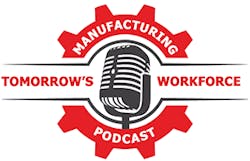Who will help build the robots?
Sometimes, if you want something done—if you want to see change happen—you’ve got to do it (or at least start on it) yourself. That’s the position that Anthony Nighswander, president of APT Manufacturing Solutions in Hicksville, OH, found himself in a few years ago.
Nighswander was frustrated: Business was good, but he was struggling find local workers with the skills his company needed. APT specializes in designing and building automation systems, but Nighswander couldn’t find the humans he needed to help build APT-made robots. The young people coming out of area high schools and colleges didn’t have the engineering and machining proficiencies that APT depends upon. So Tony decided that APT would take the lead on building the talent pipeline that it needed.
In 2015, APT opened a 75,000-square-foot training center inside its manufacturing facility, designed specifically for training high school students. Students who participate in APT’s program attend high school in the morning and head over to APT in the afternoon. There, they learn how to build a robotic packaging cell for a hypothetical APT customer.
At the end of the program, top-performing students are offered an apprenticeship, and the company pays for them to take classes at Northwest State Community College.
It’s a multipronged effort that took a lot of effort and a lot of partnering, but Nighswander says he’s seeing it pay off. He spoke with Plant Services managing editor Christine LaFave Grace about the program recently for an episode of Putman Media’s Manufacturing Tomorrow’s Workforce podcast series. Following is a portion of that conversation.
MTW: How did you decide that this was the direction that you wanted to go in for APT, with an in-house training center and an apprenticeship program?
AN: So Hicksville, Ohio, is in northwest Ohio; we’re really a farm community. I had tried working with our local career centers; they didn’t have robotic classes; they didn’t have good machining classes. I was trying to work with our community college. I was kind of under the gun as far as being in survival mode with our growth. So, I mentioned in a meeting: “You know, I’m frustrated. I’m thinking about just starting my own high school training program.” When I said that, (Defiance County Economic Development executive direcor) Jerry Hayes’ eyes lit up and the mayor’s eyes lit up, and they said, “We’ve been talking about this; we’ll support you on it.” And so that was the beginning.
MTW: What skills are students learning? What aptitudes did you want to prioritize?
AN: The first thing students do is go through what we call the “tools of the trade”—they learn our language. We teach them what’s a gauge, what’s a bridgeport mill, what’s a lathe.
The second thing they do is visionary engineering. They start building a machine in their mind, and then we come up with a bill of materials, what can we buy and what do we have to make, and then they draw up what they have to make. In their first year, they’re not allowed to use the computer; we feel that designing comes from the brain from being visionaries. We teach them how to draw on paper and 3D-sketch it on paper, and now it’s instilled in their heads.
Then they go on the floor and they machine their parts. And whenever they go on the floor, they’re surrounded by usually five to 10 mentors in those departments. Our tool-makers and machinists really get excited when the kids come out, and they’re working with them for three weeks.
Then they go into the welding department and they weld their parts together, and then they go to the automation floor and they assemble their parts.
They learn to program robots, they learn to program PLCs, and they learn to program HMIs. Really, what we’re trying to do is find out what they’re good at and what their skill is, and then we can help nurture that skill.
Click here to listen to the full interview.
To listen to more episodes of Manufacturing Tomorrow's Workforce or subscribe to the podcast, click here.

